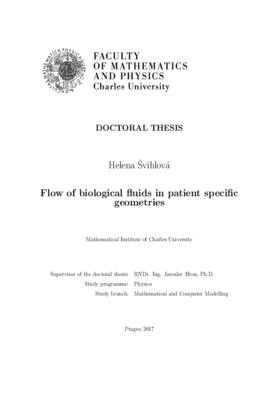Flow of biological fluids in patient specific geometries
Proudění biologických tekutin v reálných geometriích
dizertační práce (OBHÁJENO)

Zobrazit/
Trvalý odkaz
http://hdl.handle.net/20.500.11956/94165Identifikátory
SIS: 142583
Kolekce
- Kvalifikační práce [11196]
Autor
Vedoucí práce
Oponent práce
Bertoglio, Cristóbal
Mardal, Kent-Andre
Fakulta / součást
Matematicko-fyzikální fakulta
Obor
Matematické a počítačové modelování
Katedra / ústav / klinika
Matematický ústav UK
Datum obhajoby
27. 11. 2017
Nakladatel
Univerzita Karlova, Matematicko-fyzikální fakultaJazyk
Angličtina
Známka
Prospěl/a
Klíčová slova (česky)
Reálné geometrie, Mozková výduť, Stenotická chlopeň, Poissonova rovnice pro tlak, Nitscheho metodaKlíčová slova (anglicky)
Patient specific geometries, Cerebral aneurysm, Stenotic valve, Pressure Poisson Equation, Nitsche's method1 Abstrakt: Časově závislé trojrozměrné proudění Newtonovské tekutiny je studováno v kontextu dvou bio- mechanických aplikací, proudění v mozkových výdutích a proudění ve stenotických cévách. V první části práce jsou výpočetní sítě, získané z medicínských zobrazovacích technik, použity na výpočet hemodynamických parametrů spojovaných s možností prasknutí mozkových výdutí. Hlavním výsledkem je výpočet ve dvaceti geometriích výdutí. Je ukázáno, že velikost výdutě hraje důležitější roli pro rozložení smykového napětí na stěnách než fakt, zda je výdut' prasklá nebo neprasklá. Druhá část práce je zaměřena na proudění ve stenotických chlopních. Je ukázáno, že metoda používaná v současnosti v lékařské praxi je založena na předpokladech, které jsou příliš omezující pro aplikace proudění krve v reálném případě. Je prezentován kompletní model mechaniky kontinua s fyziologicky relevantními okrajovými podmínkami a je ukázáno, že výsledky jsou konzistentní s naměřenými daty získanými z lite- ratury. Dále se zaměřujeme na získání tlakového pole z rychlostního pole. Prezentovaná metoda poskytuje přes- nější aproximaci tlaku než běžně používaná Poissonova rovnice pro tlak. Poslední kapitola práce se věnuje Nitscheho metodě pro slip okrajovou podmínku. Numerické výsledky jsou...
1 Abstract: Time-dependent and three-dimensional flow of Newtonian fluid is studied in context of two biomechanical applications, flow in cerebral aneurysms and flow in stenotic valves. In the first part of the thesis, the computational meshes obtained from the medical imaging techniques are used for the computation of hemodynamic parameters associated with the rupture potency of the cerebral aneurysms. The main result is the computation within twenty geometries of aneurysms. It is shown that the aneurysm size has more important role in wall shear stress distribution than the fact whether the aneurysm is ruptured or unruptured. The second part of the thesis is addressed to the flow in stenotic valves. It is shown that the method cur- rently used in medical practice is based on assumptions which are too restrictive to be apply to blood flow in the real case. The full continuum mechanics model is presented with physiologically relevant boundary conditions and it is shown that results are consistent with measured data obtained from literature. Then we focus on the obtaining the pressure field from the velocity field. The presented method provides more accurate pressure approximation than commonly used Pressure Poisson Equation. The last chapter of the thesis is dedicated to Nitsche's method for treating slip boundary...
